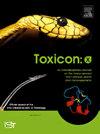Pathophysiological role of endothelial biomarkers in Bothrops sp. venom-induced renal dysfunction and the therapeutic effect of antivenom
IF 2.8
Q2 TOXICOLOGY
引用次数: 0
Abstract
Snakebite antivenom (SAV) is the standard treatment option to neutralize the toxic effects of snake venom, but their consequences on kidney function need to be better understood. This study aims to evaluate the effects of antivenom on kidney and endothelial biomarkers due to Bothrops venom in two subgroups of patients distinguished by the presence of hemorrhagic syndrome at admission. This prospective study included 34 snakebite patients admitted to a tertiary hospital in Northeast Brazil between August 2019 and November 2020, 50 % of whom experienced spontaneous bleeding. Endothelial and kidney damage biomarkers were analyzed at three time points: before antivenom infusion and after 10 h and 20 h of antivenom infusion. Bleeding patients exhibited higher urine Neutrophil Gelatinase-Associated Lipocalin (uNGAL) and Kidney Injury Molecule-1 (KIM-1) levels, indicating incomplete renal recovery until 20h after antivenom. This group showed higher serum angiopoietin-2 (Ang-2) levels and vascular cell adhesion molecule-1 (VCAM-1). VCAM-1 levels positively correlated with kidney biomarker levels at each time point, especially after SAV. uNGAL was variant across VCAM-1, Ang-1, and Ang-2 levels before antivenom. Elevated levels of uNGAL and KIM-1, observed 10 h after SAV administration, may indicate incomplete renal protection and a potential risk for the development of chronic kidney injury, requiring future follow-up.

内皮生物标志物在猪血蛇毒诱导的肾功能障碍中的病理生理作用及抗蛇毒血清的治疗效果
抗蛇毒血清(SAV)是消除蛇毒毒性作用的标准治疗选择,但其对肾功能的影响需要更好地了解。本研究旨在评估抗蛇毒血清对两组以入院时出现出血综合征为特征的患者肾脏和内皮生物标志物的影响。这项前瞻性研究包括2019年8月至2020年11月期间巴西东北部一家三级医院收治的34名蛇咬伤患者,其中50%出现自发性出血。在抗蛇毒血清输注前、输注10 h和20 h后三个时间点分析内皮和肾脏损伤生物标志物。出血患者尿中性粒细胞明胶酶相关脂钙素(uNGAL)和肾损伤分子-1 (KIM-1)水平较高,表明抗毒血清后20小时肾脏恢复不完全。血清血管生成素-2 (ang2)和血管细胞粘附分子-1 (VCAM-1)水平升高。各时间点VCAM-1水平与肾脏生物标志物水平呈正相关,尤其是SAV后。在抗蛇毒血清之前,uNGAL在VCAM-1、Ang-1和Ang-2水平上是不同的。在SAV给药后10小时观察到uNGAL和KIM-1水平升高,可能表明肾脏保护不完全,有发展为慢性肾损伤的潜在风险,需要进一步随访。
本文章由计算机程序翻译,如有差异,请以英文原文为准。
求助全文
约1分钟内获得全文
求助全文
来源期刊

Toxicon: X
Pharmacology, Toxicology and Pharmaceutics-Toxicology
CiteScore
6.50
自引率
0.00%
发文量
33
审稿时长
14 weeks
 求助内容:
求助内容: 应助结果提醒方式:
应助结果提醒方式:


